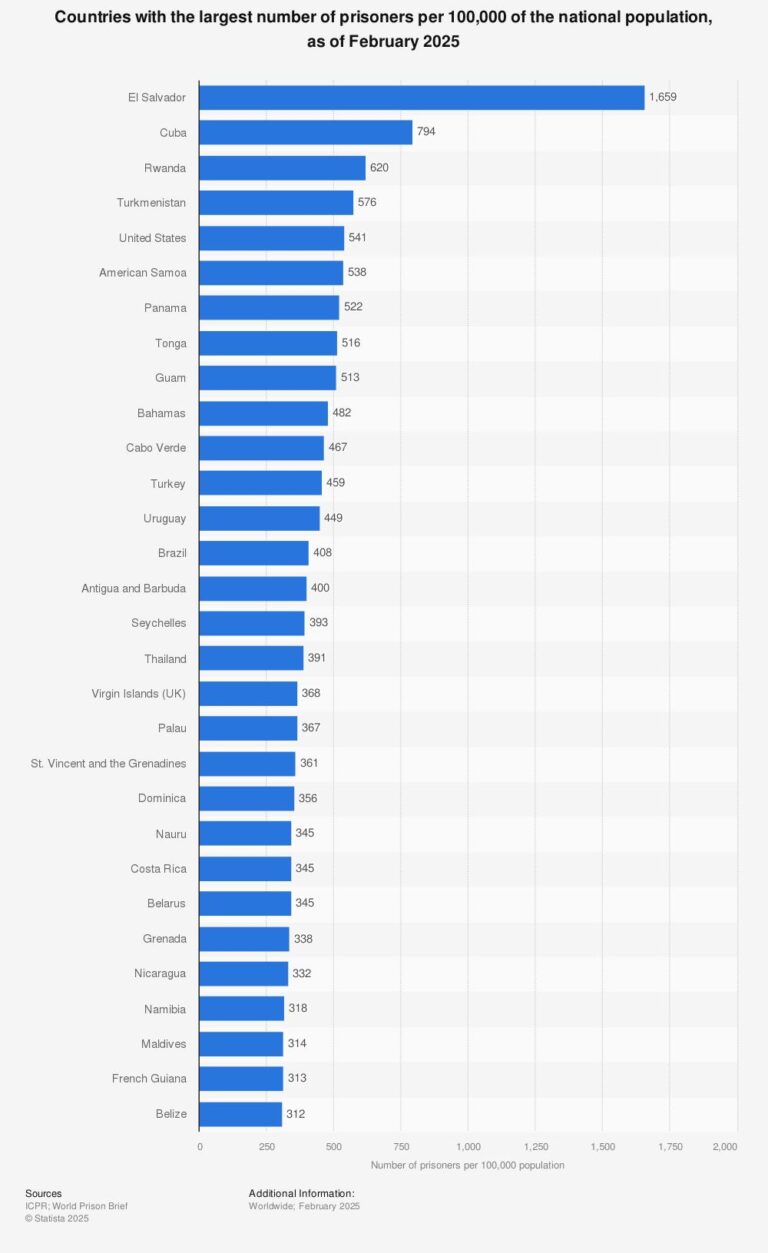The prison population in France continues to draw significant attention as new data for 2024 reveals evolving trends within the country’s correctional system. According to the latest statistics from Statista, France’s incarcerated population reflects broader social, legal, and policy dynamics affecting the justice system. This article delves into the current figures, compares them with previous years, and explores the implications for policymakers, prison reform advocates, and the general public.
Rising Trends in France’s Prison Population and Contributing Factors
France has witnessed a steady increase in its prison population over recent years, reflecting complex societal challenges. Among the primary factors driving this trend is the rise in minor offenses related to drug possession and theft, placing additional strain on correctional facilities. Additionally, changes in judicial policies, particularly stricter sentencing for repeat offenders and reduced use of probation measures, have contributed to the growing numbers behind bars. The lack of alternative sentencing options and limited investment in rehabilitation programs also play a significant role in the overcrowding crisis.
Demographic shifts are another crucial element influencing incarceration rates. Young adults from economically disadvantaged urban areas constitute a disproportionate share of new inmates, highlighting issues of social inequality and exclusion. Furthermore, the increasing number of foreign nationals in prisons points to challenges in integration and migrant support policies. Authorities are now exploring a combination of measures to stem this upward trajectory, including expanding capacity and enhancing prevention strategies targeting at-risk populations.
| Contributing Factor | Impact on Population |
|---|---|
| Drug-Related Offenses | 35% increase over 5 years |
| Stricter Sentencing Laws | 20% rise in repeat offender sentences |
| Economic Disparities | High incarceration among low-income youth |
| Foreign Nationals | 15% of total prison population |
Analyzing Demographic Shifts and Inmate Profiles in French Prisons
Recent trends indicate a significant transformation in the demographic composition of France’s prison population. Notably, there has been a marked increase in the percentage of younger inmates aged between 18 and 25, now accounting for nearly 30% of the total incarcerated individuals. This shift is closely linked to rising offenses related to drug trafficking and street-level crimes. Gender distribution remains predominantly male, but the female inmate population has shown a steady 5% rise over the past five years, highlighting changing patterns in criminal behavior and sentencing policies.
Examining inmate profiles reveals a complex matrix of social and economic factors. A large proportion of detainees have a history of unemployment, limited formal education, and come from urban areas with high poverty rates. Below is a snapshot of key demographic indicators within French prisons in 2024:
| Demographic Factor | Percentage |
|---|---|
| Ages 18-25 | 29.7% |
| Female Inmates | 7.3% |
| Unemployed Prior to Incarceration | 44.1% |
| Inmates with Less Than Secondary Education | 62.5% |
Impact of Overcrowding on Rehabilitation and Prison Conditions
France’s prison system continues to grapple with severe overcrowding, significantly impairing efforts toward effective rehabilitation. When facilities exceed their intended capacity, the strain on resources limits access to educational programs, vocational training, and psychological support essential for reintegration. This environment fosters heightened tensions and reduces inmates’ motivation to engage in rehabilitative activities. The lack of personal space and privacy further exacerbates mental health issues, creating a cycle where overcrowded conditions directly hinder prospects of successful social reintegration.
Key consequences of overcrowding include:
- Increased incidence of violence and conflicts among inmates
- Reduced availability of rehab programs and health services
- Deterioration of physical infrastructure and sanitation
- Impeded staff ability to manage and support prisoners
| Factor | Impact |
|---|---|
| Inmate Density | 150% over capacity on average |
| Rehab Program Availability | Reduced by 30% |
| Reported Violence Incidents | Increased by 45% year-on-year |
| Staff-to-Inmate Ratio | 1:7, down from 1:5 |
Policy Recommendations to Address Growth and Improve Correctional Outcomes
To effectively manage the rising prison population in France, policymakers should prioritize alternatives to incarceration that focus on rehabilitation rather than punishment. Expanding probation programs and community service options can reduce overcrowding while promoting social reintegration. Additionally, investing in mental health and addiction support within correctional facilities can address underlying causes of criminal behavior, ultimately decreasing recidivism rates. Strengthening collaboration between judicial authorities and social services is crucial to ensuring that intervention measures are tailored to the individual’s needs and circumstances.
Key strategies include:
- Enhancing vocational training and educational opportunities for inmates
- Implementing restorative justice programs focused on reconciliation
- Increasing transparency and data-driven decision-making to allocate resources efficiently
- Creating specialized units for vulnerable populations such as juveniles and mentally ill offenders
| Policy Measure | Expected Impact |
|---|---|
| Expanded Probation Options | 20% reduction in prison intake |
| Mental Health Programs | 15% lower recidivism rates |
| Vocational Training | Improved post-release employment by 25% |
| Restorative Justice | Stronger community ties, reduced repeat offenses |
Concluding Remarks
As France continues to grapple with the complexities of its prison system, the 2024 statistics from Statista offer critical insight into the evolving landscape of incarceration. Understanding these figures is essential for policymakers, stakeholders, and the public alike as efforts toward reform and rehabilitation progress. Continued monitoring and analysis will be key to addressing the challenges faced by the French penitentiary system in the years ahead.




